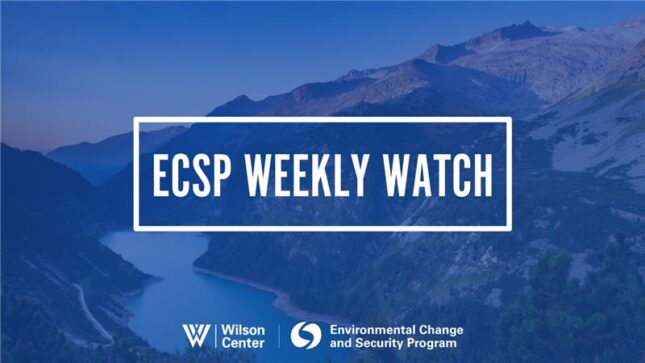-
ECSP Weekly Watch | November 4 – 8
November 8, 2024 By Neeraja Kulkarni
A window into what we’re reading at the Wilson Center’s Environmental Change and Security Program
Can Fighting Smog Be a Bridge in India-Pakistan Relations? (Al Jazeera)
The Swiss group IQAir has compiled and analyzed data from 14 regional monitoring stations and declared Pakistan’s capital Lahore to be the world’s most polluted city. Last Wednesday, for instance, Lahore’s air quality index (AQI) score was 1165, which then increased in a staggering fashion to 1900 AQI by the following Monday. India’s capital, New Delhi, was a close second for most-polluted city in the same survey, however. This cross-border pollution issue now has led government officials in both countries to reignite stagnant relations to pursue solutions.
Weather patterns, the impact of colder air in winter, vehicular pollution, and stubble burning are key factors that create worsening air quality in most South Asian countries. Pakistan’s government has now set up a “smog war room” comprising staff from eight departments to focus on human security and address the nation’s worsening pollution. This committee will study weather and air quality forecasts, as well as monitor the senior officers in charge of implementing the next steps.
This cross-border pollution issue also highlights an urgent need for bilateral platforms that might accelerate technical cooperation and innovation to addressing root causes and strengthen community resilience against adverse health impacts. Punjab’s (Pakistan) Chief Minister Maryam Nawaz Sharif even observed that that winds don’t have borders, and extended a request to discuss matters with her Indian counterpart, the Chief Minister of India’s Punjab, Bhagwant Mann. It was a move that emphasizes the urgency of mitigating air pollution in a collaborative way.
READ | The 2024 Emissions Gap Report: A Clarion Call for Mandatory Commitments?
The Aftermath of Spain’s Deadly Flash Floods (AP News)
Last week’s unprecedented flash floods in Spain were followed by heavy downpours in its eastern regions that left hundreds of people trapped in vehicles, homes, and offices. Fatalities reached 217 people, with 211 of them residing in Valencia—the worst-hit city. Unprecedented payout requests are already in motion, and the nation’s insurance companies have deemed the incident as the worst disaster in Spain’s recent history. While relief efforts continue, the shocking incident has drawn national attention to Spain’s shortcomings in governance.
Volunteers and the military have led recovery efforts to clear wreckage, help the displaced and injured persons, and find missing people. Communities also have faced severe property losses, including damaged ground floors of houses and muddy farms that will leave adverse economic impacts.
In all the chaos, local communities in the affected regions increasingly blame the government for not taking required precautionary measures—including providing timely warnings. This week, their frustrations led members of a crowd in hard-hit Paiporta to throw mud and other objects at Spain’s royals, Prime Minister Pedro Sánchez, and regional officials during a visit to tour the city. In identifying the incident’s interlinkages with climate change, scientists hope to underscore the need to accelerate mitigation and build community resilience in Spain’s vulnerable regions.
READ | Before the Flood: Lessons from Attempts to Predict Displacement
Uncertainties Surround Geoengineering Methane Removal (Mongabay)
Methane emissions contribute to one-third of all global air pollution. Two-thirds of that amount is caused by human activities, including livestock husbandry, agriculture, fossil fuels, climate change, and landfills. This growing challenge has propelled geoengineering innovations to find answers, including removing methane through chemical processes. Despite the fact that these geoengineering solutions remain controversial, one new solution is sparking worldwide discussion.
This solution is the iron salt method—also known as atmospheric oxidation enhancement. It involves breaking down atmospheric methane molecules by injecting iron salts, which leave behind vapor and CO2. Yet this process is risky, and carries the risk of breaking down the ozone layer, which might worsen outcomes in combating climate change.
This growing dialogue on atmospheric methane removal has mixed support from scientists and technical experts. A lack of practical evidence for its efficacy has led, scientists to emphasize the need to address the human causes of methane emissions simultaneously—or tackle them before geoengineering solutions reach the market. The rise of such innovations is also a warning call, however, and is prodding nations to develop national and international frameworks to address ethical and economic implications.
READ | Responsible Research Won’t Be Enough to Control Solar Geoengineering
Sources: Reuters, National Public Radio (NPR), Associated Press News (AP News), Mongabay, Al Jazeera
Topics: climate, climate change, climate finance, Eye On, flooding, geopolitics, India, meta, methane, Pakistan, pollution
 A Publication of the Stimson Center.
A Publication of the Stimson Center.






